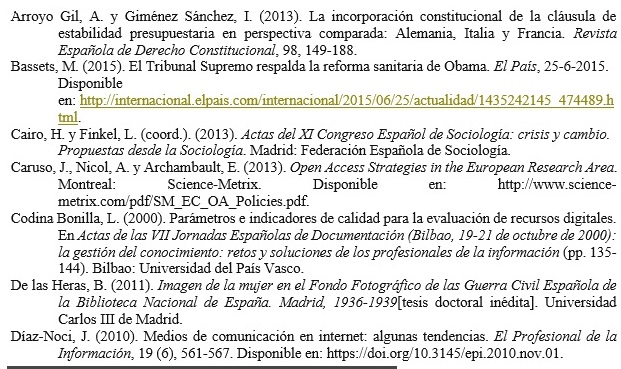1. Os traballos presentados para a súa publicación na Revista deben ser inéditos e non estar aprobados para a súa publicación noutra revista.
2. Os traballos deben aterse ás normas técnicas de publicación seguintes. Os orixinais que non se suxeiten ás devanditas normas serán devoltos ós autores para a súa adaptación e corrección, antes de ser enviados ás persoas encargadas de avalialos.
Primeira.- Contidos dos orixinais.
1. Dereito publica traballos orixinais de investigación sobre calquera das especialidades das Ciencias Xurídicas, así como estudios relacionados coa impartición da docencia universitaria, caracterizados pola súa orixinalidade e calidade.
2. Dereito edítase semestralmente, podendo publicarse, anualmente e de forma extraordinaria, un número monográfico.
3. Cada número ordinario consta das seguintes seccións permanentes:
- Estudos: son traballos de investigación ou achegas doutrinais.
- Comentarios e crónicas:
- Eséxese de sentencias, de borradores de normas, de novas normas ou de documentos técnico-xurídicos.
- Resumos dos contidos de congresos, cursos, seminarios ou outros actos académicos de interese xurídico celebrados na Universidade de Santiago de Compostela.
- Descricións de experiencias de innovación docente.
- Notas: son traballos breves de opinión científica sobre temas de actualidade xurídica.
- Recensións: son comentarios de libros editados preferentemente no ano anterior ó de publicación do correspondente número da Revista.
Eventualmente poderase incorporar á Revista por decisión do Consello de Redacción una cuarta sección titulada “Informes”. Os Informes son traballos de divulgación das principais novidades normativas, xurisprudenciais ou técnico-xurídicas ocorridas nun sector dunha área ou materia xurídica no ámbito autonómico, estatal ou internacional. O seu obxectivo é describir as modificacións introducidas no sector respectivo e realizar unha análise crítica das mesmas.
Segunda.- Extensión e formato dos orixinais.
As extensións mínimas e máximas son:
- Estudos doutrinais: 15-45 páxinas.
- Comentarios e crónicas: 5-15 páxinas.
- Notas: ata 15 páxinas.
- Recensións: 2-5 páxinas.
- Informes: 15-30 páxinas
O formato debe axustarse ós seguintes criterios:
a) Os traballos aparecerán firmados polas autoras ou autores, con nome, apelidos, categoría profesional e indicación da institución á que pertenzan.
b) Os traballos deberán incluír, en primeiro lugar, na lingua do traballo, en castelán e en inglés: un título; un sumario; un resumo de entre 125 e 150 palabras; entre 3 e 5 palabras chave, e, en segundo lugar, o corpo do traballo e unha bibliografía, ordenada alfabeticamente.
c) Os títulos deberán expor, na medida do posible, o tema ou a tese que se defende no traballo. Os resumos deben reflectir as principais ideas nas que se articula o traballo de investigación. As palabras chave serán extraídas dun tesauro de difusión xeral. A filiación profesional do autor consistirá na indicación da categoría profesional da autora ou do autor e da institución a que está vinculado ou na expresión do seu grao académico e da institución a que está vinculado.
d) O formato standard da Revista baséase en páxinas DIN-A4, con marxes de 2,5 cm., tipo de letra “Verdana” tamaño 12 (as notas a pé de páxina co mesmo tipo de letra, pero en tamaño 10) e espacio e medio de interliñado (as notas a pé de páxina a espacio simple).
e) O título do traballo presentarase en maiúsculas, centrado e en negritas. O nome das autoras ou autores situarase baixo o título, centrado, en minúsculas e en cursiva. Debaixo do nome indicarase a categoría ou grao académico e debaixo deste a Universidade ou institución á que esta vinculado (sen cursiva nin negrita).
f) O texto estructurase en parágrafos sen sangrado, xustificados, cun espaciado anterior de 6 e posterior de 0 puntos (as notas a pé de páxina terán un espaciado anterior e posterior de 0 puntos).
g) A estructura do traballo debe seguir o modelo: 1. TÍTULO DO APARTADO (maiúsculas, redonda e negrita); 1.1. Título do subapartado (minúsculas, redonda e negrita); 1.1.1. Título do subapartado (minúsculas, negrita e cursiva), 1.1.1.1 Título do subapartado (minúsculas e cursiva) e 1.1.1.1.1 Título do subapartado (minúsculas e redonda).
h) As citas, en estilo APA, faranse da seguinte forma:

i) É preceptivo incorporar como ligazon (URL) o DOI de todas as obras incluídas na bibliografía que o posúan. No portal de procuras de CrossRef poden buscarse as obras para determinar se teñen DOI e, neste caso, cal é este. Velaquí un exemplo de referencia dun artigo con DOI:
j) As referencias das citas consignaranse a pé de páxina e a súa numeración será continua.
k) As palabras, expresións e citas que aparezan en lingua distinta á do artigo deben escribirse en cursiva.
l) Non se admiten subraiados.
m) Nunha nota ó principio do traballo indicaranse as abreviaturas empregadas no mesmo. En todo caso: a palabra páxina abreviarase p. ou pp., segundo proceda, e seguintes será ss.
n) As siglas deben escribirse sen puntos (ex. EBEP). A primeira vez que apareza nun artigo unha sigla, débese escribir o nome completo seguido da sigla entre paréntese.
o) As citas textuais de sentencias ou de opinións de autores deben ir entre os símbolos: « ».
p) Non se incluirán debuxos, fotos ou ilustracións.
Terceira.- Remisión, avaliación e aceptación dos orixinais.
1. Os traballos presentados deberán ser inéditos e non estar aprobados para a súa publicación noutra revista. Enviaranse nun formato compatible co programa informático de tratamento de textos “Microsoft Word” .
2. Os prazos de presentación de traballos para a súa publicación na Revista rematan o último día dos meses de marzo e setembro.
3. Os traballos presentados a Dereito serán sometidos a avaliación confidencial por dous expertos. Non se publicarán os traballos que teñan dúas avaliacións negativas. Aqueles que obteñan unha avaliación positiva e outra negativa, serán enviados a un terceiro avaliador e só serán aceptados para a súa publicación no caso de que esta última avaliación sexa positiva.
4. A Secretaría do Consello de Redacción comunicará ós autores a aceptación ou non polo Consello de Redacción dos orixinais remitidos, así como, de ser o caso, o número da Revista no que se incluirán. A Revista dará constancia das datas de envío e aceptación dos orixinais publicados.


